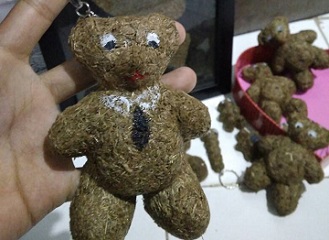A Unique Handicraft Made by IPB Students from Cow Rumen Contents

Every year over 2 million heads of cattle are cut to meet the need for the domestic beef. For Bogor City area, the slaughter of cattle in the slaughter house (SH) of Bubulak reaches 50 cows per day. Each cut of one cow produces 10 kilograms of rumen waste, so 50 heads of cattle produce about 500 kilograms of rumen waste. Indonesia has approximately 420 SHs, mostly located in Java. One can calculate the amount of waste from the rumen.
The rumen content is the remaining feed in the cow rumen after slaughtering. The content of rumen is a by-product of slaughterhouses so far not utilized optimally and even mostly thrown away. This rumen content can cause environmental pollution, e.g. air pollution, if not handled properly.
To reduce the negative effects, a group of Bogor Agricultural University (IPB) students turn the waste of rumen contents into products of economic value. It is used as "KLISE", (a handicraft made from Rumen Waste). The Student Creativity Program Group (PKM) consist of Rizqi Nurlaeli, Ratriana Titis Malinda, Arif Wicaksono Saputra, Lisa Loretta Venezia, and Rachmat Triyono.
The high motivation to be young entrepreneurs and get additional income is behind Rachmat Triyono and four colleagues to participate in this PKM. "I have always intended to open a business in handicraft. But at that time, I was still confused to determine what different raw materials to use and have an added value," said Rachmat. He also said that he finally found an idea to use rumen waste from his field of science at the Faculty of Animal Husbandry. While doing the laboratory practices, Rachmat noticed the unused rumen content. Then he studied the characteristics of the rumen content and found that it is suitable for uses as a handicraft material.
The rumen waste from cows will be made into handmade dolls and keychains. The process of making starts with washing the wet rumen waste and then drying it. Once dry, it is glued with a wooden adhesive. Finally, the glued material is put into various shape molds and dried again. So far, the development of KLISE products has reached the stage of finishing and a feasibility testing. "We have not received the order because it has not been marketed. We want to make sure first that our products are really worth selling. But we plan to make a book cover also from this waste," said Rachmat with a big hope. (Mtd)



